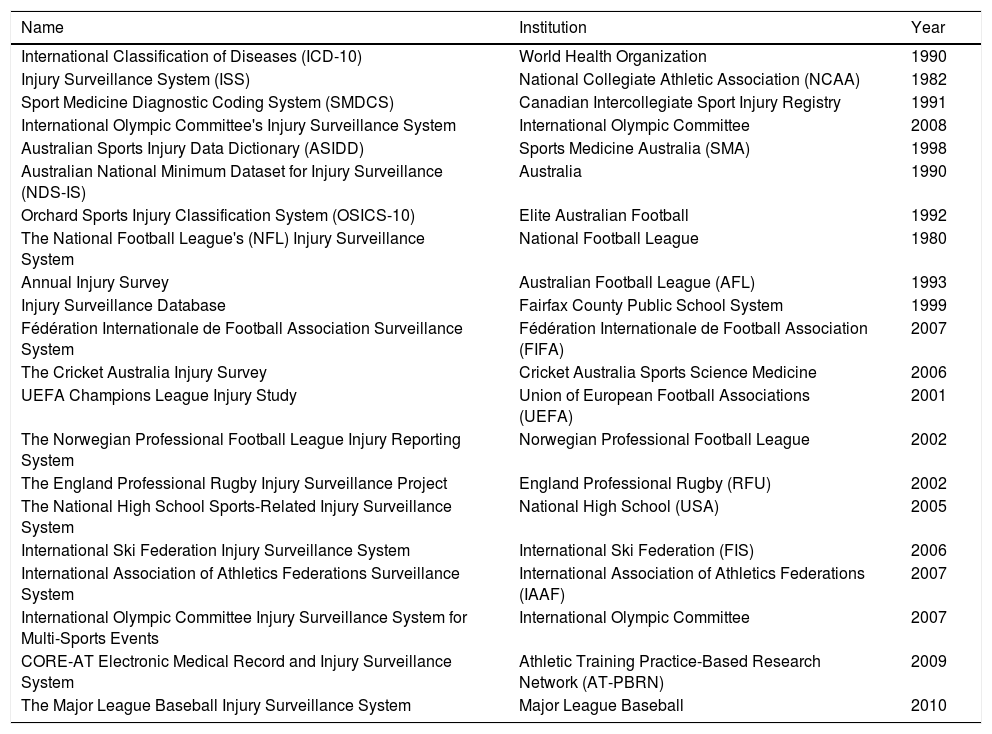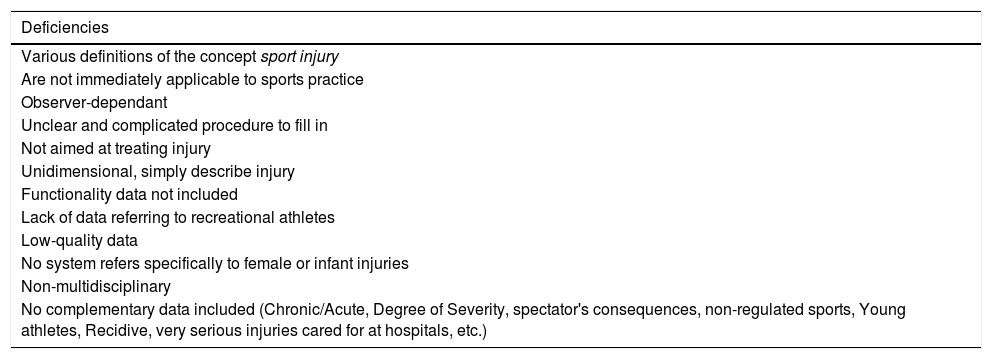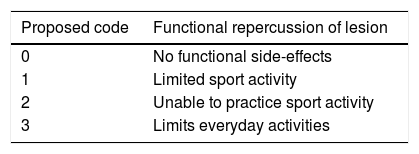To publish the Spanish translation of version 12 of the sports injury classification system called Orchard Sports Injury Classification System and propose a modification to include a numerical code which reflects the impact of the injury on sports functionality.
MethodThe members of the working group on the epidemiology of sports injury, of the Group for the Study of the Muscle-Tendon System (GESMUTE), and of the Spanish Society of Sports Traumatology (SETRADE), carried out a bibliographical review on the epidemiological classification systems of injuries, three face-to-face consensus meetings and various online pieces of work, following the DELPHI work methodology.
ResultsThe Spanish translation of version 12 of the Orchard Sports Injury Classification System is fully accessible and free of charge at:
https://gesmute.es/traduccion-espanola-osics-12/The current project proposes to add, at the end of the current coding system of version 12, a numerical code (0: No Functional impairment; 1: Limits Sports Activity; 2: Prevents Sports Activity; 3: Limits Daily Life Activities), to indicate any functional repercussions caused by the injury.
ConclusionsWe present the Spanish translation of version 12 of the Orchard Sports Injury Classification System. We propose as an improvement the inclusion of functionality criteria in sports injury classifications; more specifically, our proposal could be an improvement to the Orchard Sports Injury Classification System version 12.
The Group for the Study of the Muscle-Tendon System (GESMUTE) is made up of specialists in various disciplines, all of them affiliated to the Spanish Society of Sports Traumatology (SETRADE). Within GESMUTE, the work group for the epidemiology of sports injury has analyzed the most commonly used classification systems in sports injuries, with the aim of assessing the pros and cons of each system used and propose one of them to GESMUTE, so that it may apply such a system for any of its future studies.
There are many classifications (Table 1) and one of the most commonly used was created in 1992 by Dr. Orchard, named Orchard Sports Injury Classification System (OSICS)1 which is currently in its version 12. Version10 had previously been translated to Spanish1,5–7 and it was now version 12's turn to be translated also into Spanish.8
Most commonly used classification systems for diseases and disorders.1–4,7,9,10
| Name | Institution | Year |
|---|---|---|
| International Classification of Diseases (ICD-10) | World Health Organization | 1990 |
| Injury Surveillance System (ISS) | National Collegiate Athletic Association (NCAA) | 1982 |
| Sport Medicine Diagnostic Coding System (SMDCS) | Canadian Intercollegiate Sport Injury Registry | 1991 |
| International Olympic Committee's Injury Surveillance System | International Olympic Committee | 2008 |
| Australian Sports Injury Data Dictionary (ASIDD) | Sports Medicine Australia (SMA) | 1998 |
| Australian National Minimum Dataset for Injury Surveillance (NDS-IS) | Australia | 1990 |
| Orchard Sports Injury Classification System (OSICS-10) | Elite Australian Football | 1992 |
| The National Football League's (NFL) Injury Surveillance System | National Football League | 1980 |
| Annual Injury Survey | Australian Football League (AFL) | 1993 |
| Injury Surveillance Database | Fairfax County Public School System | 1999 |
| Fédération Internationale de Football Association Surveillance System | Fédération Internationale de Football Association (FIFA) | 2007 |
| The Cricket Australia Injury Survey | Cricket Australia Sports Science Medicine | 2006 |
| UEFA Champions League Injury Study | Union of European Football Associations (UEFA) | 2001 |
| The Norwegian Professional Football League Injury Reporting System | Norwegian Professional Football League | 2002 |
| The England Professional Rugby Injury Surveillance Project | England Professional Rugby (RFU) | 2002 |
| The National High School Sports-Related Injury Surveillance System | National High School (USA) | 2005 |
| International Ski Federation Injury Surveillance System | International Ski Federation (FIS) | 2006 |
| International Association of Athletics Federations Surveillance System | International Association of Athletics Federations (IAAF) | 2007 |
| International Olympic Committee Injury Surveillance System for Multi-Sports Events | International Olympic Committee | 2007 |
| CORE-AT Electronic Medical Record and Injury Surveillance System | Athletic Training Practice-Based Research Network (AT-PBRN) | 2009 |
| The Major League Baseball Injury Surveillance System | Major League Baseball | 2010 |
The various fore-mentioned systems proposed1,2,4,10 usually include a questionnaire-based document which collects data related to the injury or sports accident which are later introduced into a data base to be analyzed and studied, with the aim of:
- 1.
Establish preventive measures.
- 2.
Optimize the rules of the game for every sport.
- 3.
Enable institutions to adequately plan health assistance during sporting events.
Despite being useful when it comes to performing epidemiologic studies and providing healthcare support, these systems are not constraint-free (Table 2),1,4,6,7,10 enough reason to spur multiple groups to improve them7,9,11 (Table 2) and reach consensuses in order to narrow the gap caused by discrepancies.10
Main deficiencies shown by sport injuries classification systems.
| Deficiencies |
|---|
| Various definitions of the concept sport injury |
| Are not immediately applicable to sports practice |
| Observer-dependant |
| Unclear and complicated procedure to fill in |
| Not aimed at treating injury |
| Unidimensional, simply describe injury |
| Functionality data not included |
| Lack of data referring to recreational athletes |
| Low-quality data |
| No system refers specifically to female or infant injuries |
| Non-multidisciplinary |
| No complementary data included (Chronic/Acute, Degree of Severity, spectator's consequences, non-regulated sports, Young athletes, Recidive, very serious injuries cared for at hospitals, etc.) |
After considering all the fore-mentioned, the GESMUTE work group decided to meet in Madrid on 22 September 2018 and agreed to analyze the different epidemiological Code-assignment systems used in sport injury classification, with the aim of choosing a single one to be applied in the future by the group. This study describes the results obtained and level of agreement reached.
MethodUsing DELPHI methodology12 (work and consensus following an in-line process structure used in group meetings) members of GESMUTE's epidemiology work group, carried out the following activities:
- -
1 September to 20 September 2018: Agreed on consensus to establish task goals to achieve.
- -
22 September 2018: GESMUTE agreed to revise and analyze all fore-mentioned injury classification systems so that one of them may be used and applied by GESMUTE in the future.
- -
23 September 2018 to 30 March 2019: revised references and analyzed the various epidemiological sport-injury classification systems.
- -
30 March 2019: GESMUTE chose the OSICS-12 classification system and reached consensus to use it in future studies. It additionally agreed to add a numerical code system which defines functional impact caused by injury.
- -
30 March 2019 to 11th November 2019: contacted Dr. Orchard so he may approve translation of the OSICS-12 classification system into Spanish. Additionally, established points to discuss for next meeting to be held on 23 November 2019 by GESMUTE.
- -
23 November 2019: Modifications proposed for the OSICS-12 classification system were approved and a functional code added.
- -
25 November to 15 December: consensus reached upon work methodology to follow when translating and also regarding full translation of OSICS-12 into Spanish.
- -
15 December 2019 to 30 January 2020: discrepancies solved, and consensus reached concerning OSICS-12 translation proposals.
- -
13 January 2020 to 20 January 2020: the Iberoamercian group (Chile, Argentina, Uruguay y México) of specialists in sports medicine were contacted and joined the main group in order to translate OSICS-12 into Spanish.
- -
30 January 2020 to 5 March 2020: OSICS-12 translation consensus was finalized.
- -
24 April 2020: Spanish version of translated OSICS-12 and proposed improvements were published in Spanish scientific journals.
All group meetings where held at Clínica CEMTRO on 22 September 2018, 30 March 2019 and 23 November 2019.
ResultsAll 1733 diagnostic terms, 41 injury categories and 13 body areas which make up the OSICS-12 system were translated. Translated information and full text in spread sheet format, is available and free at:
https://gesmute.es/traduccion-espanola-osics-12/
The most important decisions taken by all of GESMUTE work group members at their meetings were:
- -
To use the OSICS code system of sports injuries for future epidemiological studies.
- -
To translate OSICS-128 into Spanish.
- -
To categorize each injury into corresponding anatomical regions. We believe such categories help to make a more efficient use of this classification system.
- -
To propose the introduction of a modification in the OSICS-128 system which implies adding a number code at the end of the already existing code, with the aim of indicating how the injury affects this area functionally (Table 3).
Additionally, validation of OSICS-12 Spanish translation has started both in Spain and Latin-America.
DiscussionMain results in this study include GESMUTE adopting the OCICS classification system and translating into Spanish OSICS-12.8 The translated information, full text in spread sheet format, may be accessed for free on:
https://gesmute.es/category/publicaciones/
Additionally, a proposal to improve OSIC's injury classification system was made by which a final figure is added at the end of each code which indicates functional repercussion of the injury when practicing sport.
The OSICS-12 system follows a four-character structure, assigned to each injury.1,2,5,6 The first letter in this structure indicates an anatomical region, the second letter corresponds to a specific injured tissue or the name of the pathology present, the third and fourth letters describe the pathology and provide further diagnosis. This system1,5,7 is constantly updated, it is flexible enough to include new categories and adapt to new concepts8 without invalidating previous versions and has a wide-enough range to include all types of injuries. Since it was first published, its authors have refused to have any copyright ownership; it has been validated,2 its applicability has been proven7 and is widely used in sport-injury epidemiology.1,5,13 The main reasons for this system being mentioned so often in papers are that it provides a precise encoding system and that forthcoming modifications have always lead to improved versions. The OSICS system has improved over time, adding new codes and categories which allow structural anomalies to be included, as well as pathologies shown by para-athletes, pediatric injuries, post-surgical conditions, medical pathologies, administrative actions taken and data collected regarding uninjured athletes.1,5,7 Additionally, it has been translated to several languages, including Spanish.5,6,8
Classifying an injury implies describing it, as well as including it in a category and establishing its level of severeness.14
- Keeping all three of the above in mind, the applied taxonomy should14–21:
- -
Show reproducibility.
- -
Establish clear differences amongst categories.
- -
Be easily remembered.
- -
Be concise and easily understandable.
- -
Include prognosis variables.
However, the OSICS system begins to lack precision when the encoding system is applied by non-healthcare staff,2 giving ground to the proposal of variations which may somehow assess injury relapses (Subsequent injury categorization – SIC – Model).11
Sports injury research needs an appropriate encoding system for the different pathologies with the aim of truly knowing their incidence, a precise location, the injury mechanism that caused it, any efficient preventive measures to be taken, the efficacy of all different treatments applied to the same injury1,2,5,10,13 or making the right return-to-play decisions. Nevertheless, a same lesion may have various effects on the sports activity such as when an achilles paratendinopathy (Code OSICS-12: ATAP) is invariably assigned the same code, whether it is totally incapacitating for the athlete or it allows him/her to train as usual. If we wish to analyze the efficacy of various treatments or choose the kind of exercise we may apply when treating an injury, it is essential to know to what extend the injury affects sport activity. This is why the GESMUTE epidemiology work group agreed to add a number indicating the extent to which an injury functionally affects the athlete.8 As an example, take an achilles paratendinopathy which may not hinder an athlete's physical activity, that is, without functional side-effects. We would code it as ATAP-0. But if such an injury does produce pain which does not allow any kind of physical practice, we would code it ATAP-2. Such coding could be useful when establishing a treatment protocol to apply to the injury for, in the case of a non-limiting achilles paratendinopathy (ATAP-0), we may use eccentric and plyometric exercises almost limitlessly, whereas in the case of a highly functionally limiting achilles paratendinopathy (ATAP-2), those exercises would be unadvisable. We are thus favoring a collaborative approach from all sports health-care specialists, from diagnosis, treatment and rehabilitation to the prevention of injuries. Hence our position on considering it advisable to add a number after every OSICS-12 code with the aim of referencing functional impact of each and every injury.
For the future, we are considering validating the Spanish translation of OSICS-12 both in Spain and Latin-America, as well as translating into Spanish any future versions of OSICS. Furthermore, GESMUTE is promoting the development of an application program which facilitates injury code assignment using OSICS-12.
Support and financial dataThis project has received no funding of any kind. Any cost associated to any necessary activity has been met by authors themselves, by GESMUTE and by SETRADE.
Conflict of interestThe authors declare that they don’t have any conflict of interest.
- -
Dr. Tomás Fernández Jaén for his unconditional support and partnership leading to this Project coming to life.
- -
Clínica CEMTRO, in the person of its founder, Prof P. Guillén, for hosting every necessary meeting, for nurturing this project from the very beginning and for its/his support in any project related to Sports Medicine in Spain.
- -
Dr. Jean Christophe Romagnoli Prado, Dr. Begoña Zubieta Planella, Dr. Diego Barriga González and Dr. Claudio Troncoso Sepúlveda, all from the School of Sports Medicine of the Santiago de Chile University, Chile; for their contribution to the English to Spanish translation.









